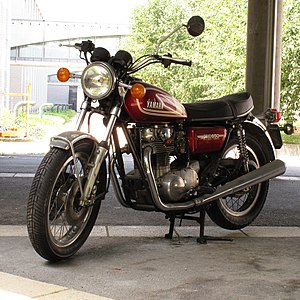Yamaha XS 650

Yamaha XS650
|
|
| Manufacturer | Yamaha Motor Company |
|---|---|
| Also called | XS-1, XS-2 |
| Parent company | Yamaha Corporation |
| Production | 1968–1985 |
| Class | Standard |
| Engine | 654 cc (39.9 cu in), 4-stroke, parallel twin, air-cooled, SOHC, 2 valves per cylinder |
| Compression ratio | 8.4:1 |
| Power | 50 bhp (37 kW) @ 7200 rpm (XS-F) |
| Torque | 54 Nm @ 6800 rpm (XS-F) |
| Ignition type |
Contact point-pre 1980 TCI-post 1980 |
| Transmission | 5-Speed, manual |
| Frame type | tubular steel |
| Suspension | Front: telescopic Rear: swinging fork |
| Brakes | Front: Single disc (earlier models); twin disc (later models) Rear: drum |
| Tires | Front: 3.50-19 Rear 4.00-18 |
| Weight | 450 lb (200 kg) (dry) |
| Fuel capacity | 3 US gal (11 L; 2 imp gal) or 4 US gal (15 L; 3 imp gal) |
Contact point-pre 1980
The Yamaha XS650 is a mid-size motorcycle made by Yamaha Motor Company. The standard model was introduced in 1968 and produced through 1979. The "Special" cruiser model was introduced in 1978 and produced through 1985. The XS650 began with the 1955 Hosk SOHC 500 twin. After about 10 years of producing 500 twin, Hosk engineers designed a 650 cc twin. Later the Hosk company was acquired by Showa Corporation, and in 1960 Yamaha had bought Showa with Hosk's early design of 650 cc twin.
When the Yamaha XS 650 was launched in 1968 it had one of the most advanced engines in its class of large parallel twin motorcycles. The engine and gearbox are unit construction with the crankcase split horizontally for ease of assembly whereas almost all contemporaries in its class in 1968 are either unit construction with a vertically split crankcase or pre-unit construction with separate engine and gearbox. The XS650's engine was used in AMA Professional Dirt Track Racing by national champion Kenny Roberts. In 1968 only the Laverda 750S, and the Honda CB350, also launched that year, matched the XS 650's modernity of unit construction and SOHC valve operation.
The 1970 model was designated the XS-1. Subsequent Yamaha Xs650 models were XS-1B (1971), XS-2 (1972), then TX (1973), TX-A (1974), XS-B (1975), XS-C (1976), XS-D (1977), XS-E (1978), XS-F (1979). 1979 was the last year of the so-called "Standards" (an unofficial term commonly used to differentate it from the "Special," which has pullback bars, a teardrop tank, and other differences in appearance). The Es and Fs also came in Special form: XS-SE (S for Special) and XS-SF. From then on they were Specials only to XS-SG, XS-SH, XS-SJ, XS-SK. There was a Special II (Two) model designation in 1978 (unknown) in 1979 (XS-SF-II), 1980 (XS-G), 1981 (XS-H) which were models with fewer chrome parts decals instead of plated plastiic on the side covers as well as drum rear brake and wire wheels versus disc rear brake or cast wheels. The Special II was offered until 1985 the last year for the XS 650.
...
Wikipedia
